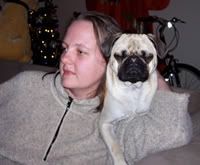Positive Reinforcement
Developed by Edward Thorndike at the turn of the 20th Century, positive reinforcement is a gentle, reduced-stress way to train dogs and owners. One of the earlier proponents of positive reinforcement for dogs was Ian Dunbar, whose books are available online through most book retailers (like Amazon and Barnes & Noble).
Reinforcement (as part of operant conditioning) is defined by Wikipedia as:
...any change in an organism's surroundings that:I think positive reinforcement is the most gentle way to teach your dog all kinds of behaviors, from basic obedience, to agility, to fun tricks. When looking for a dog trainer or dog training class, be sure to ask what kind of training methods are used, and go with one that uses positive reinforcement.
- occurs regularly when the organism behaves in a given way (that is, is contingent on a specific response), and
- is associated with an increase in the probability that the response will be made or in another measure of its strength.
For example: you give your dog food every time it sits when you tell it to. If the dog becomes more likely to sit when told to, sitting is considered to have been reinforced by the administration of food contingent on it.
Note that it is the behavior that is reinforced, not the dog. The food serves as a reinforcer, reinforcing or strengthening that behavior, only to the extent that sitting subsequently occurs more often or more quickly because of it.
Keep in mind that techniques for dealing with behavior problems such as aggression are different than those used to teach new behaviors, such as "sit" or "fetch".





